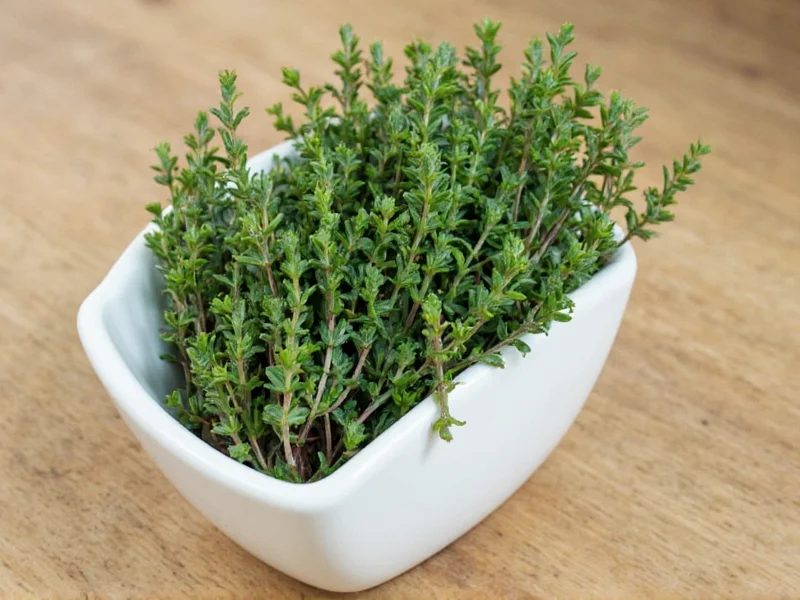Understanding thyme fresh to dry conversion is essential for precise seasoning in cooking. Fresh thyme contains more moisture, making its flavor milder than dried thyme, which has had water removed, concentrating its essential oils and potency. Using the wrong measurement can dramatically alter your dish's flavor profile.
When converting thyme measurements, remember that dried herbs generally have 2-3 times the intensity of fresh varieties. This thyme fresh to dry conversion ratio applies whether you're making soups, stews, roasted meats, or baked goods. The key is adjusting quantities to maintain balanced seasoning without overpowering your dish.
| Fresh Thyme | Dried Thyme Equivalent | Best Used For |
|---|---|---|
| 1 teaspoon | ⅛ teaspoon | Finishing dishes, delicate sauces |
| 1 tablespoon | 1 teaspoon | Standard conversion for most recipes |
| 2 tablespoons | 2 teaspoons | Heartier dishes like stews |
| ¼ cup | 4 teaspoons (1⅓ cup) | Large batch cooking, preserving |
Why the 1:3 Thyme Fresh to Dry Conversion Ratio Matters
The precise thyme measurement conversion cooking requires stems from botanical science. Fresh thyme is approximately 85% water, while dried thyme has most moisture removed. This dehydration concentrates the herb's essential oils and flavor compounds. When substituting dried thyme for fresh in recipes, using equal measurements would result in overpowering, potentially bitter flavors.
Chef's tip: For the most accurate thyme fresh to dry conversion, measure fresh thyme with leaves still on the stem, then strip and lightly pack the leaves before comparing to dried measurements. This accounts for air space between fresh leaves that doesn't exist in dried form.
Fresh vs. Dried Thyme: When to Use Each Form
Understanding when to use dried thyme instead of fresh significantly impacts your cooking results:
- Use fresh thyme for finishing dishes, in salads, with seafood, or in recipes with short cooking times where delicate flavor matters
- Use dried thyme for long-simmered dishes like soups, stews, and braises where its concentrated flavor can properly infuse
- Never substitute equal amounts—always apply the thyme fresh to dry conversion ratio to maintain proper seasoning balance
Common Thyme Conversion Mistakes to Avoid
Many home cooks make critical errors when converting thyme measurements:
- Using equal measurements instead of applying the 1:3 ratio
- Adding dried thyme too late in cooking, preventing proper flavor infusion
- Using old, stale dried thyme which has lost potency (dried herbs last 1-2 years)
- Not adjusting for thyme variety (lemon thyme, French thyme, etc. have slightly different intensities)
For the most accurate fresh thyme substitute dried thyme results, add dried thyme early in the cooking process to allow time for rehydration and flavor release. Fresh thyme works best added toward the end of cooking or as a garnish to preserve its delicate aroma.
Storage Tips for Maximum Flavor Preservation
Proper storage affects your thyme fresh to dry conversion accuracy:
- Fresh thyme: Store upright in a glass with water (like flowers), covered loosely with a plastic bag in the refrigerator for up to 2 weeks
- Dried thyme: Keep in an airtight container away from light and heat; properly stored, it maintains potency for 12-18 months
Test dried thyme potency by rubbing a small amount between your fingers—if the aroma is weak, you'll need to use slightly more than the standard thyme fresh to dry conversion ratio to achieve proper flavor.
Practical Application in Recipes
When following recipes that don't specify fresh or dried thyme, consider the dish type:
- Quick-cooking dishes (pan sauces, omelets): Assume fresh thyme
- Long-cooking dishes (soups, roasts): Assume dried thyme
- When in doubt, start with less dried thyme than the conversion suggests—you can always add more but can't remove excess
Professional chefs often combine both forms—using dried thyme early in cooking for base flavor and fresh thyme at the end for aromatic complexity. This technique creates layered seasoning that single-form usage can't achieve.
What is the exact thyme fresh to dry conversion ratio?
The standard conversion is 1 tablespoon of fresh thyme equals 1 teaspoon of dried thyme. This 1:3 ratio accounts for dried thyme's concentrated flavor due to moisture loss during the drying process. Always adjust measurements when substituting between forms to maintain proper seasoning balance in your dishes.
Can I substitute dried thyme for fresh in all recipes?
While you can substitute dried thyme for fresh in most recipes, the conversion requires adjustment using the 1:3 ratio. Dried thyme works best in long-cooking dishes like stews and soups where it has time to rehydrate. For delicate dishes, salads, or finishing touches, fresh thyme provides superior flavor and texture that dried thyme cannot replicate.
How do I adjust thyme measurements if my dried thyme is old?
If your dried thyme has lost potency (typically after 18-24 months), increase the amount by 25-50% beyond the standard conversion. Test potency by rubbing a small amount between your fingers—if the aroma is weak, you'll need more than the typical 1 teaspoon dried per 1 tablespoon fresh. Always taste as you season when using older dried herbs.
Does the thyme fresh to dry conversion differ by thyme variety?
Most common thyme varieties (English, French, lemon) follow the standard 1:3 conversion ratio. However, more delicate varieties like lemon thyme may require slight adjustments—use 25% less dried lemon thyme than standard dried thyme when substituting. Always consider the specific herb's intensity and adjust based on taste during cooking.
When should I add dried thyme versus fresh thyme during cooking?
Add dried thyme early in the cooking process (first 15-20 minutes) to allow time for rehydration and flavor infusion. Fresh thyme works best added in the last 5-10 minutes of cooking or as a garnish to preserve its delicate aroma and texture. For layered flavor, many chefs use dried thyme at the beginning and fresh thyme at the end of cooking.











 浙公网安备
33010002000092号
浙公网安备
33010002000092号 浙B2-20120091-4
浙B2-20120091-4